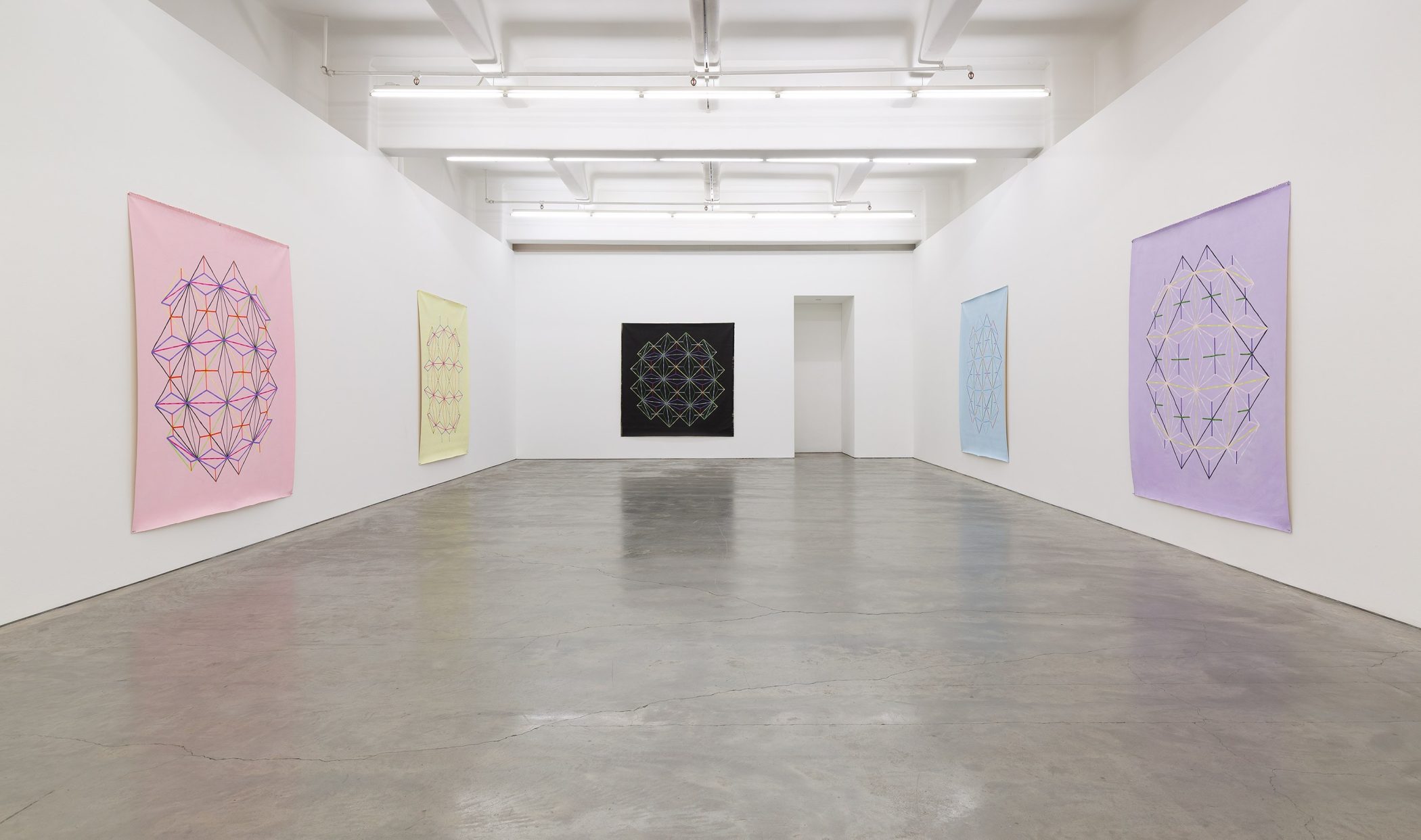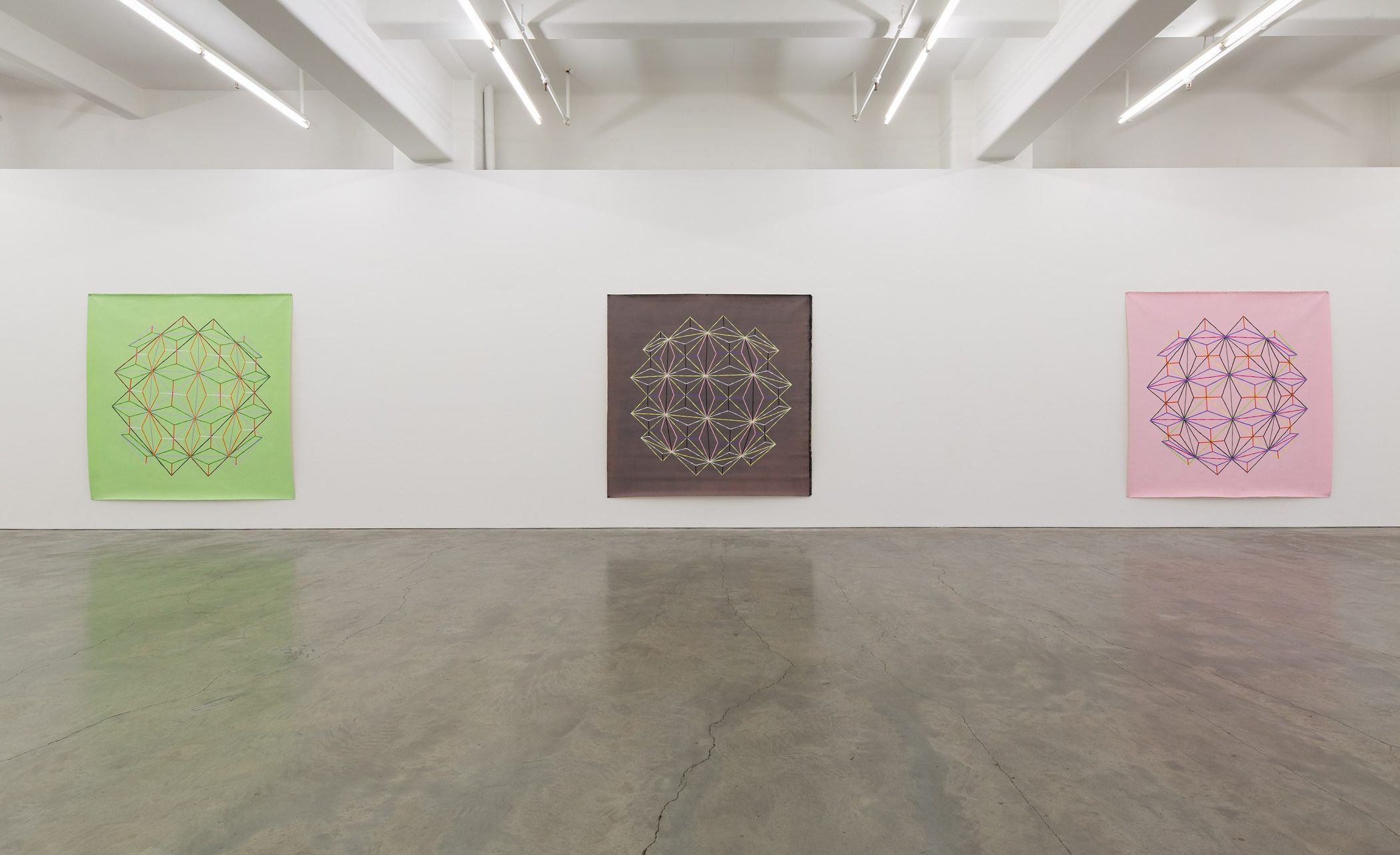Kerrie Poliness
Non-Objective Wildflowers
27th July – 7th September 2024
Anna Schwartz Gallery
Non-Objective Wildflowers at Anna Schwartz Gallery presents Kerrie Poliness’ recent investigations into the formal symmetries of parallelogram geometries, seriality and repetition. This new body of work conveys both the physical and metaphysical remnants of native wildflowers scattered across the Victorian Volcanic Plains and the kaleidoscopic resonance of their presence.
Poliness retraces the loss and memory of this wild vegetation, threatened with extinction, through the translation of energetic colour fields as a network of interconnected structures, into an optical cadence and perceptual diffraction. As the artist explains: “The ‘Sunshine Diuris’, an orchid once known as ‘Snow in the Paddock’ belongs to a colour world of tiny flowers and plants that have a particular resonance and energy which is rapidly disappearing. These paintings though, are non-objective, not representations of individual plants or flowers, rather an attempt to recall their visual magic.”
Presented as individual works, the overall composition renders a singular form or line that folds and reforms, bending into a ‘geometric wave’ and forming into a spatial elasticity or corporeal architecture, spanning the entire gallery space. Central to her preoccupation with the diamond motif as well as the structural grid; in these paintings we experience Poliness’ chromatic language as a semiotic system and as fragmented temporalities. Her ability to capture and formalize the transference of energy from these wildflowers results in an expansive geometry that shifts from subtle to vibrant hues.
Executed through a process of layering, the application of this singular line acts as an instrument to either reveal or conceal an internal, rhythmic logic. For Poliness, it is materiality itself that becomes a conduit for various interrelationships, whether tangible or intangible. This line transforms into light, sound, waves and ideas, rendering a cognitive state beyond normative perception. “The process of making the drawings replicates the nature of material growth just like nature; the same system, materials and conditions are employed to generate unique outcomes. I have developed a system of drawing geometric, organic grids that reveal difference through repetition. This process questions why we segregate the original from the copy and the synthetic from the natural,” says Poliness.
A prominent figure in the Australian art world since the 1980s, Kerrie Poliness is known for her large-scale wall drawings, often crafted by unknown collaborators from instruction manuals and site-specific installations, as well as from her contributions to the 1990s revival of abstract art in Melbourne. Alongside fellow artists Gary Wilson and Melinda Harper, Poliness launched Store 5, an artist run space focused on new experimentations which interrogated the traditional discourses of 20th Century geometric abstraction and invited members to explore makeshift materials and DIY processes.
Aesthetically aligned to the discourses of 1960s’ Conceptual Art, Op Art and Geometric Abstraction, with artists such as Sol LeWitt, Bridget Riley and Piet Mondrian, Poliness’ examinations are informed by perceptions of the material world, and finding ways of experiencing and making visible the unseen. “It’s about the physicality of the world around us, the intermingling of elements of materiality, rather than some sort of material perfection or stasis, which I see as an illusion. I’m interested in how we experience and perceive ourselves in relation to the material world.”
This enquiry can be traced back to Poliness’ early investigations from the 1990s, when she began observing the subtle differences and irregularities of patterns found in, for example, gum leaves or a manufactured object, like a tin of baked beans. She observed that whether natural or mass-produced, all objects or things are unique and distinct from each other. “All objects that are mass produced and made to look identical are actually all different. Look at atoms, their molecular structure, the materiality of everything; everything is different and in motion. This aspect of materiality connects every object in the world, human-made or otherwise; it puts everything in the same boat.”
In Non-Objective Wildflowers, viewers experience the sound of a landscape, a conceptual symphony staged by a semblance of interlacing lines. And despite its visual simplicity, this new body of work illuminates the order in nature as an intelligent structure, reflecting the complexities between harmony and dissonance. As Poliness says, “through geometry, it’s kind of like a shortcut to thinking about things that are quite complex.”
Kerrie Poliness: Non-Objective Wildflowers, Anna Schwartz Gallery, 27 July – 7 September 2024.
Melissa Bianca Amore, 2024


